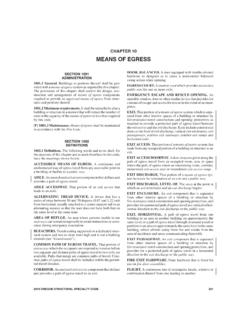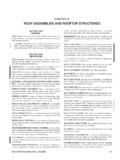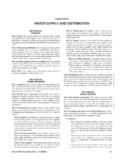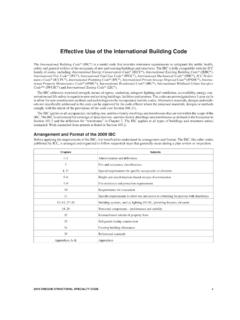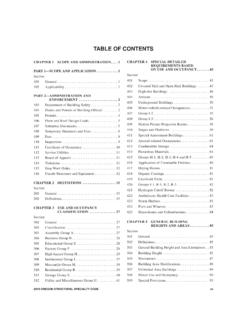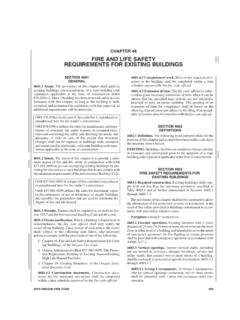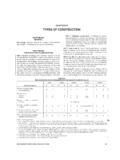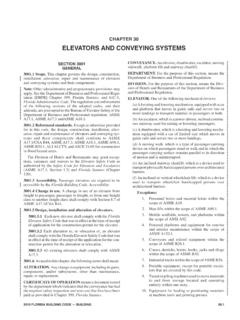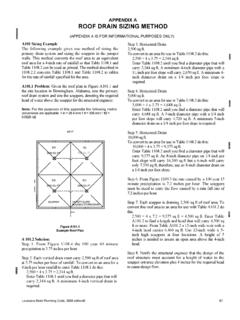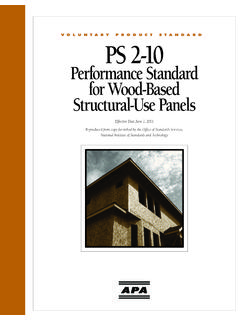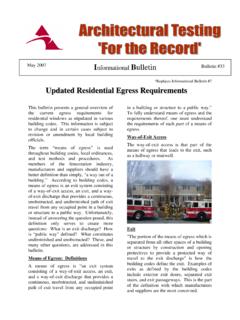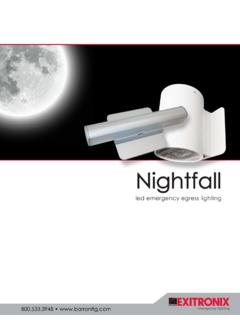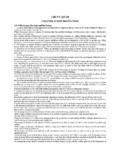Transcription of IBC – MEANS OF EGRESS Code Change No: E5-06/07
1 DOCUMENTATION 329 IBC MEANS OF EGRESS code Change No: E5-06/07 Original Proposal Sections: (IFC [B] ) Proponent: Marshall A. Klein, , Marshall A. Klein & Associates, Inc. Revise definition as follows: Definitions. The following words and terms shall, for the purposes of this chapter and as used elsewhere in this code , have the meanings shown herein. EXIT DISCHARGE, LEVEL OF. The horizontal plane located lowest story at the point at which an exit terminates and an exit discharge begins. Reason: IFC Formal Interpretations 44-03, 26-03, & 25-03, all issued on 5/11/04, stated the following: When determining stories above the lowest level of exit discharge, a level, or floor level, is not a story.
2 A level is the horizontal plane that is part of a story, not the entire story height. A story is the vertical space between the upper surface of one floor level and the upper surface of the floor level next above or below. The level of exit discharge as shown in the attached drawing of a Multi-Story Building is at elevation , the first floor level of the building is also at elevation ; therefore, the level of exit discharge and the first floor level of the building are at the same elevation. The first story of the building begins at elevation (first floor) and extends to the elevation (second floor).
3 The first story of the building is the first story above the level of exit discharge. The intent of the level of exit discharge definitions in the previous three legacy codes, and in the ICC Codes was to use a similar definition for level of exit discharge as was being used in the NFPA 101, Life Safety code , which originally defined this term. Such similar definitions for level of exit discharged correlated between model codes and the NFPA Standards for user friendliness. For reference, 2006 NFPA 101 (LSC) defines "level of exit discharge": code CHANGES RESOURCE COLLECTION INTERNATIONAL BUILDING code 330 Level of Exit Discharge.
4 (1) The lowest story from which not less than 50 percent of the required number of exits and not less than 50 percent of the required EGRESS capacity from such a story discharge directly outside at grade; (2) the story with the smallest elevation Change needed to reach grade where no story has 50 percent or more of the required number of exits and 50 percent or more of the required EGRESS capacity from such a story discharge directly outside at grade." The major difference between the IFC formal interpretations and the NFPA 101 definition is that NFPA 101 defines the level of exit discharge as a volume (story), not as a horizontal plane.
5 Therefore, in the diagram of the multistory building above, the first story above the level of exit discharge under NFPA 101 (and for that matter, as used under the legacy codes) was always considered the second story (El. 10 ). However, under the IFC Formal Interpretations, it is now the first story (El. 0 ). These formal IFC interpretations have been a rude awakening for many experienced users of the Codes, in particular to some ICC Staff members. Since a different ICC Committee, other than the ICC MEANS of EGRESS code Development Committee, made these interpretations, this code proposal is providing the MEANS of EGRESS code Development Committee its opportunity to weigh in on the intent of the code when it comes to application of this definition.
6 This code proposal is only attempting to correlate the definition for level of exit discharge with the definition in NFPA 101, where the level of exit discharge concept came from. I believe that the NFPA 101 definition is a little too wordy for the ICC Codes. My proposed wording appears more than adequate to work for the ICC Codes, and to correlate between the ICC and NFPA Codes. Cost Impact: The code Change proposal will not increase the cost of construction. Public Hearing Results Committee Action: Approved as Modified Modify the proposal as follows: EXIT DISCHARGE, LEVEL OF.
7 The lowest story at the point at which an exit terminates and an exit discharge begins. Committee Reason: The revised language will clarify that the level of exit discharge is the story the occupants are egressing from rather than the floor they are walking on. The modification was made because the story could be the lowest, highest or any level of building. Assembly Action: None Final Hearing Results E5-06/07 AM code Change No: E6-06/07 Original Proposal Sections: 1002 (New) [IFC [B] 1002 (New)]; IRC R202 Proponent: David W.
8 Cooper, Stairway Manufacturers Association THIS PROPOSAL IS ON THE AGENDA OF THE IBC MEANS OF EGRESS AND THE IRC BUILDING/ENERGY code DEVELOPMENT COMMITTEES. SEE THE TENTATIVE HEARING ORDERS FOR THESE COMMITTEES. PART I IBC Add new definition as follows: Definitions. The following words and terms shall, for the purposes of this chapter and as used elsewhere in this code , have the meanings shown herein. FLIGHT. A continuous run of rectangular treads (fliers) or winders or combination thereof from one landing to another. PART II IRC Add new definition to Section R202 as follows: FLIGHT.
9 A continuous run of rectangular treads (fliers) or winders or combination thereof from one landing to another. DOCUMENTATION 331 Reason: The purpose of the Change is to clarify the code . This proposal will foster a better understanding of what distinguishes a flight from a stairway. This definition is needed because the word Flight is used specifically to reference that part of a stairway that is between landings no less than 8 times in IBC 1009 and no less than 9 times in IRC Often this word is misinterpreted to be stairs between floors causing the extending of handrails across landings, varying determinations of handrail continuity, dimensional uniformity, riser height, and tread depth.
10 Furthermore this will help to clarify a major difference between winders and landings , Landings separate flights within a stairway, winders are treads within a flight and are often combined with fliers in the same flight. Winders do not separate flights. Cost Impact: The code Change proposal will not increase the cost of construction. Public Hearing Results PART I C IBC Committee Action: Approved as Modified Modify the proposal as follows: FLIGHT. A continuous run of rectangular treads (fliers) or winders or combination thereof from one landing to another.
